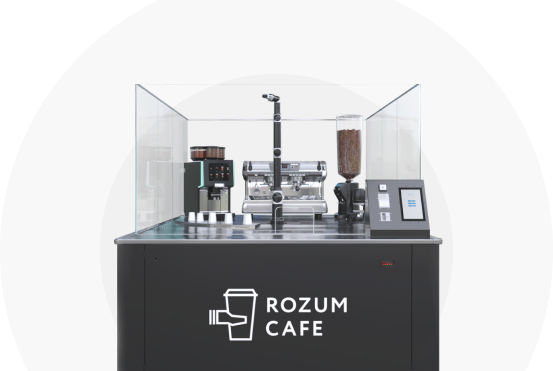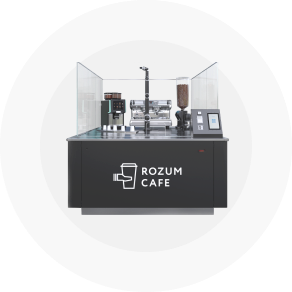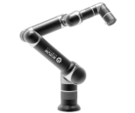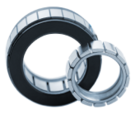What plays a role when you select an actuator to implement an automation project? Apart from the obvious criteria of price-to-performance ratio, important points include compactness, ease of integration, and usage flexibility. The products in the RDrive servo lineup are designed to drive various machinery as vertical, horizontal, or tiltable hollow shaft motor units.
The choice of a mounting alternative is rather a matter of application particulars because the mechanical interface enables installing the engines upright, in parallel, or at an angle. The body design—with a through or a solid bore—is a customizable feature, available upon request. Let us explore the options to see whether and how they can work out to your advantage.
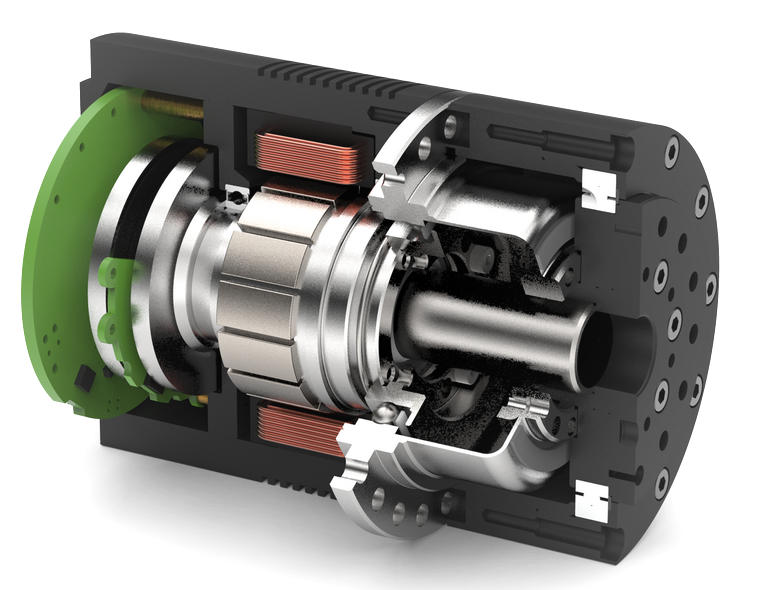
Solid vs. hollow shaft motor housing
Currently, most manufacturers and integrators aim at reducing the overall machinery dimensions without impacting power output, but solid-bore actuators have certain limitations in this respect. It becomes a real challenge to pack all the components as required to obtain high torque into a body where some space is already taken up by a shaft. Especially, if the concurrent intention is to keep weight down.
A shaftless drive resolves the problem. Whether it is a stepper, a brushless DC or AC electromotor, or a servomechanism, it has a cavity at the centre to pass utilities or other structural elements. These include electrical cabling, pneumatic or hydraulic hosing, a heat exchanger channel to dissipate excessive heat, a ballscrew, etc. Special varieties, such as pancake actuators or flat steppers, boast an extra compact footprint, ideal for tight-space applications.
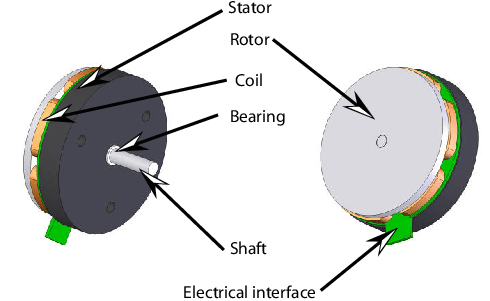
In addition to saving space and minimizing equipment dimensions, the through-shaft design of electrical motors provides other benefits, such as:
- Lighter weight as compared to a solid-bore brushless engine, stepper, or servo of the same size.
- Tight-fit and simple integration without having to align and couple together the shaft in the motor and the one in the machine. This means fewer mechanical components and misalignment errors, resulting in maximized reliability and decreased installation and maintenance costs.
- Possible direct-drive connection of a load, which improves torsional stiffness and positional accuracy, while eliminating backlash and minimizing response time.
- Enabling greater engineering and implementation flexibility by allowing to use a larger variety of orientations and motor mounting positions—vertical, horizontal, or at an angle.
- Frequency exceeding inherently that of a solid bore and a higher capacity to transmit torque.

Notwithstanding the convincing arguments above, solid shaft design may still be preferable under certain circumstances. For instance, hollow shaft drives are more sensitive to overtorque as well as to bending force effects, especially due to lateral stress. Furthermore, shafted models ensure smoother rotation even at high speeds and remain rigid even when the housing diameter is small.
Titled, horizontal, or vertical orientations
The orientation of a shafted servomechanisms for mounting purposes depends on how the shaft exits the housing: parallel to the ground or at 90 degrees to the fitting surface. Actuators with through shafts, such as in the RDrive products, boast versatile installation options—not only vertical or horizontal, but also at arbitrary angles.
Vertical hollow shaft motors have once revolutionized pump engineering. The modification from horizontal to upright made the process of embedding the motion hubs into pumps less complicated, while cutting related expenses. The modified construction has proved to be more durable, fail-safe, and easier to set up.
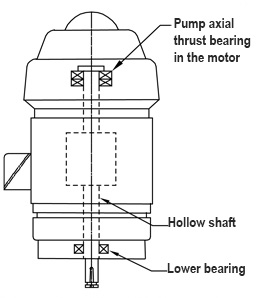
Pumps with vertical hollow shaft actuators are used at wastewater discharge and water supply facilities, as well as in pulp and paper production, well drilling, agriculture, and mining. Horizontal motors, or parallel drives, are preferred in general-purpose applications where external thrust affecting the bearing is either zero or close to the value.
Technical details:
Thrust is a force emerging as a result of an object moving in a particular direction in accordance with the third Newton’s law. The direction of the force opposes the object’s motion vector and is quantified in Newtons. Thrust is also understood as energy applied vertically to a surface.
Shaftless motors capable of operating as part of mounts with various orientations—vertical, tilted, parallel—are of special value in robotics. In particular, advantages of servos by Rozum Robotics in robotic applications are as follows:
- Compact footprint in combination with a through bore enable cost-efficient integration and versatile mounting arrangements, including at specific angles.
- Moderate weight lightens the overall structure with no adverse efect on robot performance.
- In the reduced-size hollow shaft housing, the motors accommodate two encoders, a harmonic gear set, and a controller to provide high torque and precision.
- Support of the CAN standard makes it possible to build multiple functional axes, setting up motors to enable propulsion in different orientations, while being on the same chain.

Besides robotics and pumps, hollow shaft motors, positioned at vertical angles or otherwise, help to upgrade industrial machinery with ample capabilities. Because size is small, the devices have low moment of inertia, entailing improved efficiency and dynamic performance. The construction is robust and easy-to-fit. Engineers have the freedom to design installations at their discretion, while also economizing on maintenance and production floorspace. Presses, extruders, moulding and broaching machines are just a few examples where through-bore engines provide tangible benefits.
With the RDrive products driving your machinery, you obtain all of the above and even more. The smart controller brain, backed up with the CANOpen and an Application Programming Interface, accounts for remarkable manageability of the servomechanisms. Seamless integration with process control systems and helpful statistics about manufacturing workflows from encoder feedback are in the profit pack, too.
